From the moment I decided to visit Eastern Europe I was obsessed with the idea of Transylvania. My mind conjured images of razorback mountains with rugged roads where one false move would send hikers plunging to their deaths. I imagined black-green forests so dense that not even the midday sun could penetrate and wolves howling beneath the spilled glitter of the Milky Way. Though I’d ignored the Twilight TV series that had gripped the collective fascination, I read Bran Stoker’s Dracula prior to arriving in Romania; as a result the Transylvania in my mind was also peppered with visions of vampires and Dracula. A romantic at heart, I desperately wanted to believe that this corner of the world was still remote, untouched, and mysterious.
However, Transylvania is a very large region in northern Romania, so when I left Turda I had a decision to make. I could head due south to Sibiu or southeast to Brasov. In the end I chose the latter for its proximity to Bran Castle, better known as Dracula’s Castle in tourism circles. I arrived in Brasov late one afternoon following a long, hot train ride, only to be held up by a taxi driver who tried to charge me more than four times the normal rate to take me to Old Town. Instead, I squeezed into a few inches of space on the stairs of an overloaded bus and held on for dear life as we careened around curves, simultaneously swiping at the sweat pouring down my forehead while trying to keep my suitcase from rolling out each time we jolted to a stop and the doors flew open.
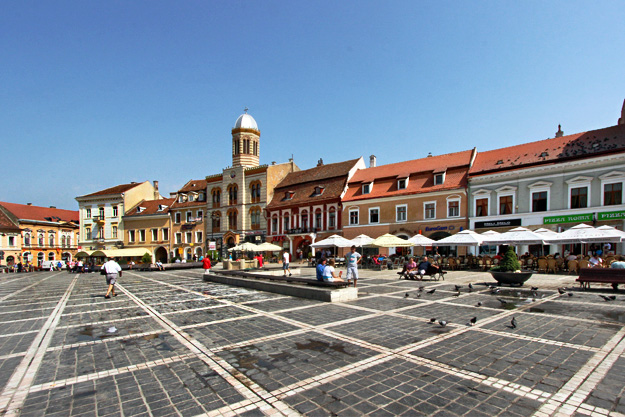
After a delicious dinner and a good night’s sleep I left the frustrations of the precious day behind and headed out to see Brasov. Piata Sfatului, the town’s main square, was a disappointment. The central fountain was dry and trash was strewn around its base. Many of the stone pavers were chipped or cracked and some were missing entirely. A worker trickling water onto spilled ice cream stains succeeded only in making them stickier. Further along I found Nicolae Titulescu Park where I strolled through neglected rose gardens. Circling back, I followed a path alongside earthen fortifications built to protect the town during medieval times. A rank odor rose from a small stream that bordered the path and gray soap scum floated on its surface. Brasov seemed seedy, dilapidated, and poorly maintained – a town in decay.
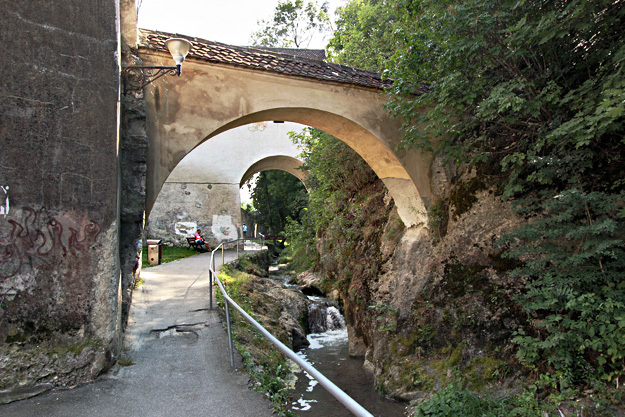
Discouraged, I spurned Brasov and booked a tour of the surrounding countryside the following day, where I was certain I would discover the real Transylvania. We drove south into Carpathian Mountains that were every bit as spectacular as I had imagined. Sinuous roads led past clusters of Swiss chalets tucked into the haunches of soaring granite giants. Since I was the only client that day, we made an unscheduled stop at the Christian/Orthodox Caraiman Monastery (Holy Cross Monastery) in Busteni, which was completed in 2000. My guide, who “got religion” after years spent negotiating arms deals for the communist government, explained that the Virgin Mary appeared in the dreams of a local priest, father Gherontie Puiu, indicating where the monastery should be built by making a flaming cross appear in the sky. Today a neon cross hangs in a large tree on that very spot and pilgrims flock to the site to offer prayers or seek healing.
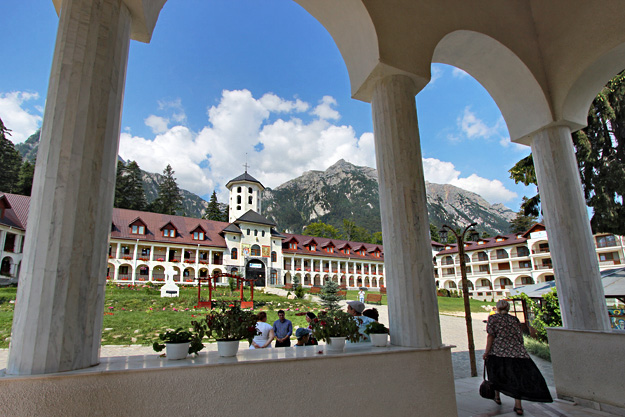
We continued south to Sinaia, another Swiss clone village where Peles Castle rests atop a rock aerie, its needle-like turrets mimicking the serrated peaks that frame it. Technically a palace, Peles was built for King Carol I, who fell in love with the Transylvanian scenery during his first ever visit to the area in 1866. Construction was begun seven years later and the castle was opened in 1883, though it was not completed until 1914. I toured parts of the first and second floors, seeing only a fraction of its 34,000 square feet and 170 rooms, but what I saw was magnificent.
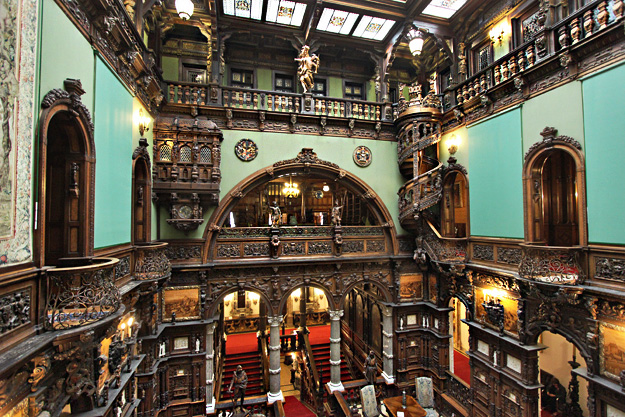
In the three-story Hall of Honor, exquisite balconies, a spiral staircase, and a prayer cabinet are carved from exotic woods and a retractable stained glass roof floods the space with natural light. A salon decorated in Moorish style features mother-of-pearl inlaid furniture, Persian rugs, and a marble fountain. The solid bronze doors of the Italian Renaissance style Florentine Room were made in Rome and the Grand Marble Fireplace has Michelangelo motifs. The Turkish parlor, used as a mens’ smoking room, is full of Turkish rugs and copperware, and its walls are covered in silk brocade imported from Vienna. The castle has one of the most extensive collections of art in Eastern and Central Europe, including more than 4,000 pieces of armor.
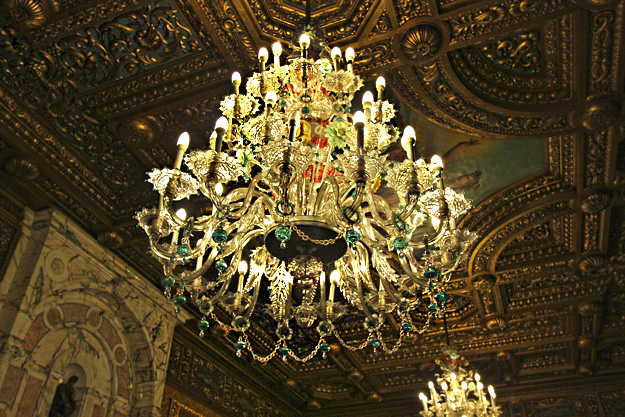
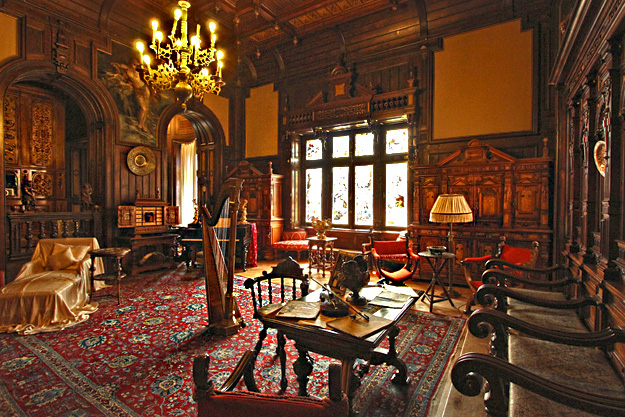
Two hours later I climbed back in the car, eager to visit the highlight of the tour, Bran Castle. Goosebumps broke out on my arms when it came into view, soaring high above the town. The massive stone hulk squatted beneath terracotta spires that seemed to have been attached at random, with no concern for aesthetics. From a distance, it was impressive. Up close, it was a circus. The streets were filled with kiosks and tents selling food and trinkets. I grimaced and pressed through the crowds of tourists, hiking up the hill to the castle entrance. Most of the rooms were unfurnished, cold, and damp, containing only signboards that explained the history of the castle and the legend of Dracula.
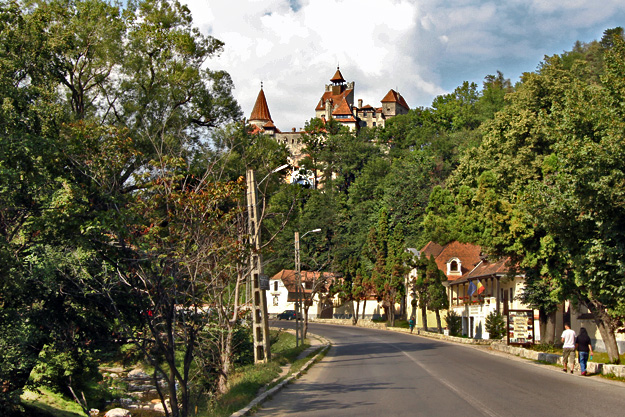
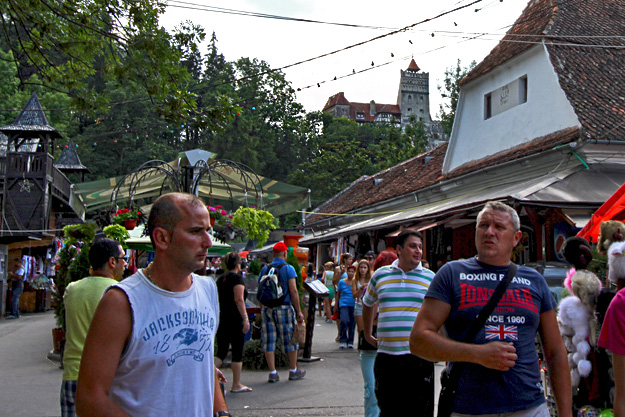
Of course, I knew that Dracula was a mythical character, created by Bram Stoker and loosely based on the true-life stories of Vlad Dracul II, a Romanian prince who, in 1448, was appointed by the Ottomans to rule Wallachia, an area that borders present day Transylvania. Vlad was supposed to be governing on behalf of the Ottomans but he was an ambitions tyrant who wanted lands of his own, and he knew that the quickest way to succeed was to establish a reign of terror. He began cutting off the heads of his enemies and mounting them on stakes in front of the castle, earning him the nickname Vlad the Impaler. But the name that would forever become associated with him came from his membership in the Order of the Dragon, an organization created by the King of Hungary to ensure the safety of the royal family and later, to protect Christianity against its enemies. Upon his appointment to the order Vlad signed the official documents with the moniker Dracula.

Fearing that control of Wallachia would be wrested from them, the Turks eventually marched against Vlad but when Muhammad II, conqueror of Constantinople, arrived he found the heads of his entire army gruesomely displayed on stakes for miles surrounding the castle. Unfortunately, that castle was not in Bran. Though historians do not agree on the location of Dracula’s Castle, Snagov Monastery and Poienari Fortress, both located in the southern Carpathians, are more likely candidates. So why does the legend persist and why do tourists flock to this false monument? Although Vlad the Impaler never set foot in Bran Castle, it was the inspiration for Bram Stoker’s Dracula, the novel that established the legend.
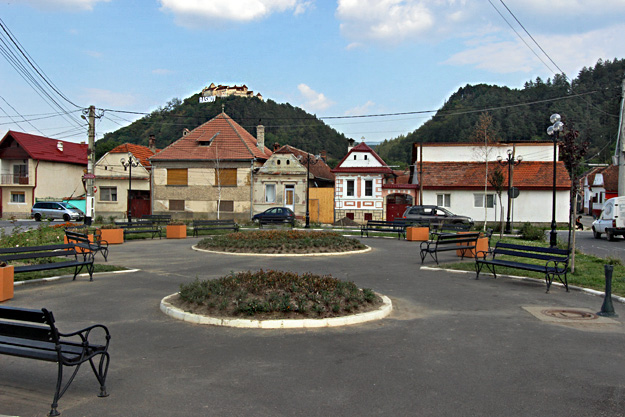
My tour continued for another hour; we made a final stop at Rasnov Fortress on our way back to Brasov, but my heart was not in it. I gazed up at the fortress, on a hill overlooking the village of Rasnov, and shook my head. Too tired to tackle one more climb, I settled for a view from afar. I stayed one more day in Brasov and it was a bad decision, as I got food poisoning from the restaurant I chose on my final night and spent the rest of the night chained to the bathroom. Brasov was a huge disappointment to me but I can still look on the bright side; at least I got out of there with my head intact.
Check prices for accommodations in Brasov at Booking.com, Hotels.com, or HotelsCombined.com. Read reviews about hotels and guest houses in Brasov, Romania at TripAdvisor.
Disclosure: This article contains affiliate links to hotel booking sites. If you click on any of the links and make a booking, I may earn a small commission, which keeps this blog free to read.

I’m sorry your trip wasn’t pleasant. However, you need to understand went in completely blind, without doing any prior research. I understand wanting to be surprised, but it’s not the most practical decision. It’s important to research the country you’re visiting so you know what to be prepared for. Otherwise you’ll either have too high or unrealistic expectations which will only ruin the experience for you.
Hi Isobel: I guess we’ll just have to agree to disagree. Everyone has their preferred method of travel, and mine is to do so without a lot of research. I believe it gives me an unvarnished experience.
I’m not here to tell you that it’s okay that you got food poisoning, or that you nearly got overcharged, and that you need to be happy about things like that. But the way you talk about Brasov and a lot of the public spaces around it comes off a bit entitled. You’re a visitor to these people’s country, and you’re remarking about how dirty and smelly this town was when you were essentially a guest there (obviously they’re benefiting from your tourism dollars, but still, it doesn’t come across as very respectful of the place or its people). It’s not just a tourist site, it’s a real place where people live, and it doesn’t just exist for tourists to consume.
It comes off like you came to the area with very specific expectations already in place, rather than being ready to let the place be what it is. You seem to be framing those frustrated expectations as a “sham” (which I think for most people has connotations of something being “fake” or a “scam” or something), rather than your own understanding and the limited Western cultural mythology around the place just not being close to the reality of it. It is what it is, and no one there was trying to scam you (except that taxi driver, it sounds like).
Similarly, the title is also kind of annoyingly clickbait-y. I understand why you’d want to write a somewhat sensational title, but I don’t think it’s great to position yourself as some kind of victim of a “sham” visited upon you by this town you chose to travel to. Especially given the often-unstable political and economic conditions of Eastern Europe, and the fact that a lot of places there really are still “developing” (if that’s a category of grouping nations/areas that we’re going to use).
I just know that if someone visited my hometown as a tourist and then wrote about it this way, I’d feel a bit insulted, given that they’re an outsider to the community, not necessarily aware of our challenges or needs, and acting like we should have prepared specifically for their visit and made them and their expectations our first priority.
I’m not trying to discourage you from traveling or writing, and I don’t claim to know you as a person, but in my opinion as a new reader, this is how you’re coming across within this article.
Dear MK: I appreciate the time you took to write a comment, however I want to respond to some of what you said. First, you said: “I’m not here to tell you that it’s okay that you got food poisoning, or that you nearly got overcharged.” Point in case. I did get food poisoning and I was nearly overcharged by taxi drivers who regularly scam tourists. Second, I never visit a new place with expectations. That’s the reason I never do much research ahead of going to a new place. I want to be surprised by it. Third, I have more than 3,200 stories on my blog and less than 10 of them are negative. I don’t write “clickbait-y” articles to get traffic. I write the truth about my experience. If it’s negative or bad, I say so. My readers expect the truth from me and I have an obligation to tell it to them straight.
Thank you for another informative site. Where else could I get that kind of info written in such a perfect way? I have a project that I’m just now working on, and I have been on the look out for such information.
Thank you for talking about such an interesting place to visit. I liked your blog. As a novice traveler, this is very useful information. I dream to visit Romania.
You’re very welcome Tori. Hope you get to visit someday.
Such a piece of great information about the legend of Dracula Brasov Romania
Thanks Utazzo. Glad you found my story interesting.
It’s sad that this article is so prominent on Google, when the places visited, were straight out of the tourist brochure. Yet you complain they were too touristy. I hope you see the painful irony in your dissatisfaction. It reminds me of when I was stood next to a Texan for half an hour waiting to see Blarney Castle which he was most disappointed with because it looked nothing like a ‘real Disney castle’ his American upbringing clearly stopped him from understanding the brutal history of Europe, or appreciate the importance (or lack of) of a building standing for hundreds of years, to spend significant sums of money on what would have been knocked down to build a mall on prime realestate on in an American city.
Have you visited the ‘other half’ of Transylvania? The citidels of Sighisoara, wooden churches, rasnov is even a better choice than the urban sprawl of Brasov, the national forests, the Roman ruins, even Targu muers has its charms. Did you stop at the replica monestary of Sinai’s at Catherines monestary… In Romania’s Sinai, a lovely town. My advice, would be to hire a car and wander on wheels.
I am here now with my little princess and she will be writing up her trip on her site. She is 2 but incredibly eloquent and bright. And I am not just being a proud parent here, she is gifted. We are finding Transylvania an excellent family holiday destination and enjoying the hidden Romania we have not read about anywhere. Well not in English anyway.
Ps I loved your write up of the salt mines
Hi Jim: I have visited the “other half” of Transylvania, as you call it. In addition to Brasov, I’ve been to Rasnov, Cluj Napoca, Busteni, and Sinaia (yes, I’ve been to Catherine’s Monastery), among other places. In Maramures, I’ve been to Satu Mare, Baia Mare, and Breb. Although not technically in the province of Transylvania, the neighboring regions of Maramures, Crisana, and Banat have historically been considered part of Transylvania. I’ve also traveled exhaustively in far east Hungary to see the old wooden churches, wooden crosses in the graveyards, old mills, and the vast grasslands. I’ve written glowingly about each of them. But with respect, I really think you missed the point. The story you reference was about one place in Romania, Brasov, and more specifically about Bran Castle. My point is that Bran Castle is a complete tourist trap and should be avoided in favor of all the other things the country has to offer. I stand by that assessment. I feel an obligation to my readers to report when something is not worth spending money to see. If you haven’t read about all those other places anywhere else in English, might I suggest revisiting some of my 46 my stories about Romania: https://holeinthedonut.com/tag/romania/
how is Bran castle a tourist trap?
It really seems like people act like the expectations they bring to a place are the place’s problem, and not their own problem to cope with.